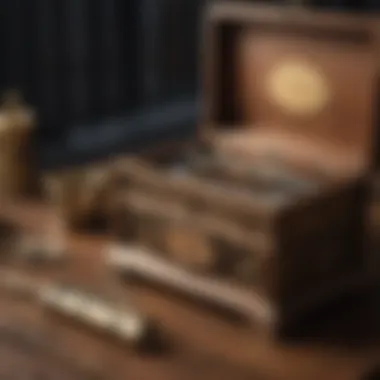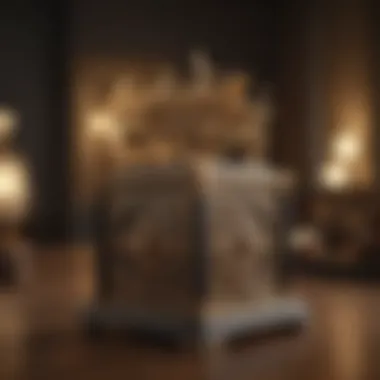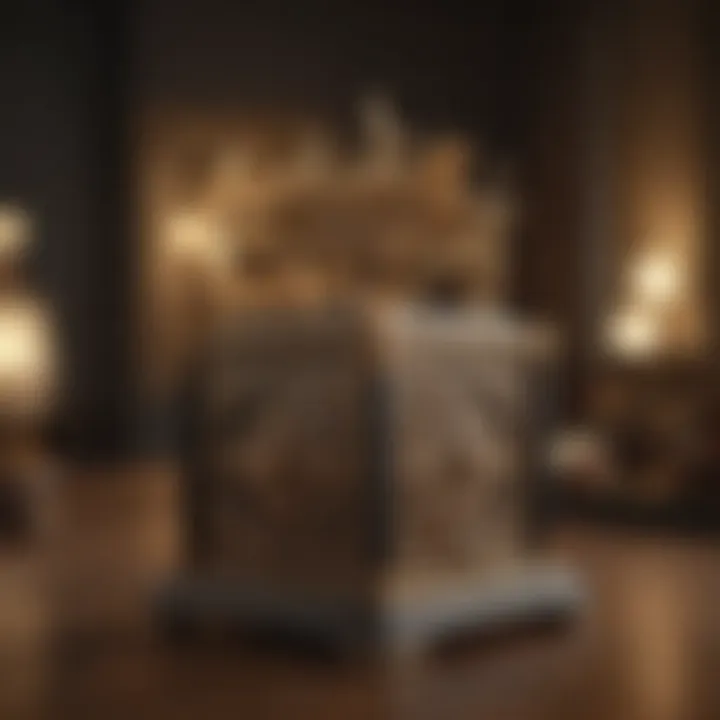The Cultural Significance of A Thousand Years Music Box


Intro
The music box has long held a unique position in the world of musical instruments, often evoking nostalgia and wonder. Among these intricate devices, the ’A Thousand Years’ music box stands out due to its connection with contemporary culture and emotional storytelling. This article delves into the cultural and musical significance of this specific music box, exploring its origins, craftsmanship, and its role in modern music appreciation.
We will analyze the song's historical context, technical aspects of music boxes, and their relevance in today's music culture. The focus is on enhancing understanding of music’s evolution and its emotional impact, using this distinctive musical instrument as a focal point.
Artist Profile
Biography and Background
The song ‘A Thousand Years’ was composed by Christina Perri and became widely known after its feature in the ‘Twilight Saga: Breaking Dawn – Part 1’ film. Released in 2011, this heartfelt ballad swiftly resonated with audiences, leading to a cultural phenomenon surrounding not only the song but also its various interpretations, including those through music boxes. Perri's personal experiences and emotional depth significantly contributed to the creation of this piece, making it a staple in romantic playlists.
Major Influences and Inspirations
Christina Perri's influences are deeply rooted in her own life experiences, as well as notable artists such as Sara Bareilles and Alanis Morissette. These influences shine through in her lyrical storytelling and melodic structuring. The song's themes of love, longing, and timelessness resonate widely, giving rise to numerous adaptations and renditions. The music box variation adds a layer of enchanting nostalgia, presenting the song in a new, tactile form.
Song Analysis
Theme and Lyrics Breakdown
‘A Thousand Years’ revolves around themes of everlasting love and the anticipation that comes with it. The lyrics express a deep commitment to a loved one, encapsulating the feeling of waiting a lifetime for that connection.
Some pivotal lines emphasize the idea of patience in love and the beauty of waiting:
• "I have loved you for a thousand years"
• "I will love you for a thousand more"
These sentiments are beautifully complemented by the gentle melodies that evoke a serene yet powerful emotion, ideal for musical expression through a music box.
Instrumentation and Composition
The composition features a blend of soft piano and strings, creating a tender atmosphere. The arrangement is simple yet highly effective, allowing the listener to engage with the emotions presented in the song. The music box rendition takes this composition and distills it into quaint, delicate notes.
The mechanics of a music box play a vital role in how the song is perceived. The winding mechanism and the placement of pins on the cylinder determine the output, encapsulating the essence of the original melody within a compact form.
A music box not only replicates the notes but also brings an enchanting quality, enhancing the emotional connection to the music.
Prologue to Music Boxes
Music boxes represent a unique convergence of art, craftsmanship, and emotion. Their mechanisms, often seen as simple toys, are capable of producing intricate melodies that resonate deeply with listeners. Understanding the role of music boxes in culture and their impact on emotional experiences is crucial, especially in the context of a popular piece such as "A Thousand Years." The beauty of music boxes lies not just in their sound, but in how they connect to memories, traditions, and artistic expression.
Definition and Overview
A music box is a device that plays music mechanically, using a set of tuned metal prongs, often referred to as tines. When a metal cylinder or disc rotates, it strikes these tines to produce sound. This simple yet effective mechanism can create a wide range of musical compositions. Music boxes can be crafted from various materials, including wood, metal, and sometimes plastic, which impacts the quality and tone of the music produced.
Music boxes have a nostalgic quality. They often evoke memories of childhood or sentimental moments, which makes them more than just musical instruments. Often gifted on special occasions or kept as family heirlooms, they hold personal significance for many. This duality of function as both an instrument and a memory keeper elevates the importance of music boxes in cultural narratives.
Historical Development
The origin of music boxes dates back to the 18th century, with early designs emerging in Switzerland. Initially, these devices were handcrafted by skilled artisans who devoted time to perfecting each mechanism. They were often elaborately decorated, reflecting the artistry of the period. Over the years, advancements in production techniques reduced the cost, making music boxes more accessible to the general public.
The evolution of music boxes continued into the 19th century, where they gained further popularity across Europe and in America. Factories began mass-producing them, and they became widely collected. The songs played on these boxes often reflected contemporary musical trends, ensuring their relevance across generations. Notably, they became part of home décor and social gatherings, adding ambiance and charm to various settings.
Through their journey, music boxes transitioned from luxury items to cherished collectibles. This historical progression illustrates their adaptability and lasting appeal. The blend of craftsmanship, nostalgia, and cultural relevance demonstrates why music boxes, such as those featuring "A Thousand Years," deserve profound examination.
A Thousand Years: A Song Analysis
The song A Thousand Years, originally performed by Christina Perri, holds significant importance in the analysis of music boxes, particularly when considering its adaptation into this unique musical instrument. This creation not only enhances the listening experience but also serves as an important cultural artifact. Understanding the song's essence, its emotional depth, and how it translates into a music box format provides valuable insights into both the song itself and the broader cultural phenomenon of music boxes.
Song Origins
A Thousand Years was first released in 2011 as part of the soundtrack for the movie The Twilight Saga: Breaking Dawn – Part 1. The song was written by Christina Perri and David Hodges. It became an instant hit, resonating with audiences due to its poignant lyrics and melodic beauty. The lyrics speak of enduring love and the passage of time, themes that have universal appeal. This universal message makes it particularly suitable for musical adaptation into a music box, which is often associated with nostalgia and cherished memories.
The musical composition, characterized by simple yet elegant melodies, invites arrangements that showcase its emotive quality. When a music box interprets A Thousand Years, it captures its essence while providing a delicate and gentle sound that enhances the emotional resonance. In this way, it preserves the song's core message and artistic intent.
Cultural Impact
The cultural influence of A Thousand Years extends beyond its initial release. The song gained immense popularity across various media, particularly within romantic contexts. It has been featured in weddings, celebrations, and other significant moments, making it part of the fabric of contemporary culture. This song's emotional weight creates a strong connection with listeners, inviting them to revisit feelings associated with love and commitment.
As a music box, A Thousand Years encapsulates this cultural significance. It becomes a physical artifact that evokes memories and emotions tied to special experiences. Furthermore, the adaptation of the song into a music box format also bridges generations. Traditional music boxes often evoke nostalgia, allowing listeners, both young and old, to connect with the song on a deeper level.
In summary, the analysis of A Thousand Years reveals its powerful origins and cultural impact. The song serves as a resonant example of how music can transcend mediums and time, becoming a cherished component of personal and collective memories.
Mechanics of Music Boxes
Understanding the mechanics of music boxes is essential for appreciating their intricate design and the beautiful sounds they produce. The mechanics play a pivotal role in both the functionality and the craftsmanship of these captivating instruments. By diving into the construction elements, sound production techniques, and material considerations, one can truly grasp the artistry behind each piece. Music boxes are not just simple toys; they are engineered marvels that combine art, music, and mechanical innovation.
Construction Elements
The construction of a music box involves several key components. At the heart of it is the movement mechanism, which includes the cylinder or disc that contains the musical notes. This cylinder is usually made of metal and is engraved with grooves that represent the notes of the tune. As the cylinder rotates, a pin or tooth plucks the metal tines which create the sound.
Other crucial construction elements include:
- Base and Housing: The outer shell provides both aesthetics and protection to the internal mechanisms. Material choices for the housing can influence the sound quality.
- Crank or Key Mechanism: This is used for winding the music box before playing. The design can either be manual or automatic, depending on the type of the music box.
- Soundboard: This component amplifies the sound produced by the tines, enhancing the music's volume and richness.


These elements are often made by skilled craftsmen who combine traditional techniques with innovative approaches to achieve a balance between functionality and artistry.
Sound Production Techniques
The sound production in music boxes is elaborate, requiring precise engineering. The notes emerge when the tines are struck by the pins on the rotating cylinder or disc. Different lengths and thicknesses of the tines produce different pitches, contributing to the overall harmony of the music.
Key techniques involved in sound production include:
- Tine Resonance: Each tine vibrates when struck, creating a distinct sound. The quality of the tin and the tuning of each tine greatly affect the overall sound profile.
- Harmonic Layering: Multi-tined music boxes often produce harmonically rich sounds by layering notes. This allows for complex melodies to be played, enhancing the listening experience.
- Soundboard Amplification: The soundboard resonates with the tines and amplifies sound. The shape and size of the soundboard are carefully designed to optimize sound projection.
This technical mastery leads to a unique auditory experience, making each music box a distinctive piece of art in its own right.
Material Considerations
The materials used in the construction of music boxes are critical not only for durability but also for sound quality. Various elements need careful consideration to ensure the right balance is achieved.
Some important material considerations include:
- Metals for Tines and Cylinders: Typically, high-quality metals such as steel are chosen for their longevity and acoustic properties. These materials provide the right amount of resonance and clarity upon being struck.
- Wood Types for Housing and Soundboard: Hardwoods such as maple or walnut are often used. They not only enhance visual appeal but also impact acoustic properties, offering warmth and richness to the sound.
- Finish and Treatment: The finish applied to enhance the look can also alter sound characteristics. Lacquers and oils add beauty while possibly affecting the sound absorption.
The Artistic Significance of a Thousand Years Music Box
The significance of the "A Thousand Years" music box extends beyond its aesthetic appeal. It embodies a unique convergence of craftsmanship, emotion, and cultural resonance that makes it a noteworthy subject for exploration. This music box captivates audiences not only through its melody but also through its connection to human experiences and emotions. By understanding its artistic significance, we can appreciate how it reflects and enhances the broader landscape of music and culture.
Emotional Resonance
The emotional connection that people have with music is profound. The "A Thousand Years" music box evokes a sense of nostalgia and longing, resonating with listeners on multiple levels. Its simplicity and charm provide a comforting backdrop for cherished memories. When individuals hear the familiar tune, they are often transported back to moments that are personally significant, whether they relate to love, loss, or reflection.
In a broader sense, music boxes often serve as vessels of emotion. They can symbolize transition periods in life or mark important milestones. The gentle notes produced by the "A Thousand Years" music box elicit a transformative experience, making listeners contemplate their own narratives. The emotional resonance of such a piece impacts not just personal sentiments but connects to cultural narratives as well.
Symbolism in Music
Music often carries symbolism, serving as a medium for deeper meanings and messages. The melody of "A Thousand Years" represents enduring love and commitment, sentiments that are universally understood. This box encapsulates those feelings in a tangible form. With its delicate construction, it stands as a metaphor for the fragility and beauty of relationships.
The music box also symbolizes the intersection of tradition and modernity. Even in contemporary times, it bridges generations, reminding us of older forms of expression while still being relevant today. Its presence in various life events, from weddings to memorials, highlights its versatile symbolism.
Music Boxes in Contemporary Culture
Music boxes have seen a notable evolution in their role within contemporary culture. Once mere curiosities, they now serve various purposes that extend beyond traditional use. This section will examine how music boxes resonate in today's world, their adaptations to modern aesthetics, and the cultural importance they hold for new generations.
Modern Adaptations
In recent years, music boxes have undergone significant transformations. Artisans and manufacturers have integrated modern technology and design into their products. Today’s music boxes can be equipped with features such as digital sound, extensive song libraries, and connectivity options. For instance, some models allow users to upload their own music, challenging the conventional notion of what a music box can be.
Furthermore, designers have embraced contemporary art trends. Sleek minimalistic designs, colorful patterns, and even themed music boxes are now available. This creativity attracts younger audiences who appreciate both the nostalgic and the fresh elements present in modern music boxes. Customization options also contribute to their appeal, as buyers can choose personalized engravings, colors, and tune selections.
Collectibility and Trends
The collectibility of music boxes has seen a resurgence alongside their modern adaptations. Collectors today are keen on rarity, brand history, and craftsmanship. Enthusiasts seek out limited edition pieces from respected manufacturers like Reuge and Symphonion but are also interested in artisanal creations that promote uniqueness. Popular trends include the rise of themed collections, where music boxes are created around popular media, holidays, or historical events.
Social media platforms, specifically Instagram and Reddit, act as vital hubs for collectors to share their finds and exchange information. As more individuals join this community, the market is witnessing increased demand for specific designs and styles, further driving interest in buying and trading these musical instruments.
"The intersection of nostalgia and modern design has breathed new life into music boxes, making them relevant for all ages."
Interest in music boxes may also stem from their therapeutic qualities. People recognize the calming effects of melodic tunes, adding another layer to their collectibility. The emotional connection that music engenders enhances the desire to own these pieces, further underscoring their status in contemporary culture.
Impact on Music Education
The importance of music in education is multifaceted, and music boxes, particularly the 'A Thousand Years' music box, provide unique opportunities for enhancing education in the subject. Music boxes serve not only as tools for teaching musical principles but also as instruments that connect students to cultural narratives. Their mechanical nature leads to inquiry-based learning, allowing students to understand the intersection of music and craftsmanship.
Incorporation into Curricula
Incorporating music boxes into music education curricula can be beneficial. Here are a few key elements:
- Hands-On Experience: Using music boxes allows students to engage with music in a tactile way. They can learn about mechanics and sound production firsthand by examining how these instruments are constructed.
- Historical Context: Teaching about the 'A Thousand Years' music box opens discussions on the historical developments in music and instrument-making. This builds an understanding of music's evolution through different cultures and eras.
- Interdisciplinary Learning: Music boxes can serve as a bridge between music education and other subjects. They can be used in art classes for design projects or in history classes to explore cultural significance and craftsmanship.
By integrating these instruments into lesson plans, educators can create a richer, more immersive learning experience.
Influencing Aspiring Musicians
The influence of the 'A Thousand Years' music box on aspiring musicians is evident in several ways:
- Motivation and Inspiration: The enchanting sound of a music box resonates emotionally, often inspiring students to explore musical composition or performance. The connection they feel can spark a lifelong interest in music.
- Development of Musical Skills: Engaging with music boxes helps students develop an understanding of melody, rhythm, and harmony. These foundational skills are crucial for their growth as musicians.
- Cultural Appreciation: Exposure to the cultural significance of music boxes helps aspiring musicians appreciate the stories and emotions behind the music. Understanding this context can inform their own musical expression and creativity.
"Music education that embraces diverse instruments like the music box cultivates not just players, but storytellers and cultural ambassadors."
In summary, the 'A Thousand Years' music box plays a pivotal role in music education by providing unique learning opportunities and fostering a profound appreciation for the art of music.
Psychological and Emotional Aspects
Understanding the psychological and emotional dimensions of music boxes, especially the 'A Thousand Years' music box, is crucial. This exploration reveals how music connects with deep-seated emotions and memories. In today's fast-paced world, the slower and melodic tunes emitted by these boxes can evoke reflection and calmness. The relationship between music and emotions is complex. It touches on nostalgia, memory, and even therapeutic applications. These aspects combine to provide a richer experience for users and collectors alike.


Nostalgia and Memory
Nostalgia plays a significant role in the experience of music boxes. For many, the gentle melodies of a music box can transport listeners back to their childhood, evoking warm memories. This emotional response is not merely sentimental; it has well-documented psychological effects. The simplicity of a lullaby can reconnect individuals with simpler times. When listening to 'A Thousand Years', one might recall a significant moment, such as a family gathering or a personal milestone.
Research has shown that nostalgia can enhance mood and foster feelings of connectedness. This emotional state can be beneficial to mental health. Individuals experiencing stress or anxiety may find solace in the familiar tunes of a music box. Moreover, personal connections to specific songs can create a layered listening experience, where each note carries the weight of past experiences.
Therapeutic Uses
The therapeutic applications of music, particularly through instruments like the music box, are gaining recognition. Music therapy is now employed to address various psychological challenges, including anxiety, depression, and even PTSD. The soft sound of a music box provides a calming effect, which is particularly helpful during therapy sessions.
Moreover, small music boxes are often used in hospice care and palliative settings. They can evoke soothing memories for patients and offer peace in challenging times. The repetitive and gentle melodies can help reduce feelings of distress, making it easier for individuals to communicate with loved ones.
In summary, both nostalgia and therapeutic uses underscore the importance of psychological and emotional aspects in the discussion of music boxes. The 'A Thousand Years' music box transcends mere ornamentation, offering a portal into the emotional landscape of individuals.
Preservation of Music Box Heritage
The preservation of music box heritage is essential for maintaining not just the instruments themselves but also the cultural narratives they embody. As physical manifestations of musical artistry, music boxes represent a significant convergence of technology, craftsmanship, and emotional expression. Their preservation ensures that future generations can engage with these cultural artifacts, appreciating their historical significance and the artistry involved in their creation.
Restoration Practices
Restoration of music boxes involves delicate work aimed at returning these instruments to their former glory. The restoration process is not just technical; it also requires a deep understanding of the original craftsmanship. Restorers often face the challenge of sourcing authentic materials that match the original components. For instance, in restoring a vintage Jaeger music box, specific clockwork mechanisms must function reliably without compromising the original tone quality. Each element of a music box, from the cylinder and comb to the casing, demands meticulous attention.
Historically, experts in this field faced a dearth of resources, but networking has expanded in recent years through online communities and forums like Reddit, where enthusiasts share their restoration projects. These connections foster a repository of shared knowledge which can significantly aid in avoiding common pitfalls during restoration. The involvement of skilled artisans ensures that the integrity and narrative of the music box is preserved.
Historical Significance
Music boxes have a deep historical significance that transcends mere functionality. They embody the evolution of music and technology, marking the transition from manual to automated music experiences. The first music boxes appeared in Europe in the late 18th century, serving as both entertainment and status symbols. Understanding their historical context offers insights into societal values and artistic trends of the time.
Additionally, the preservation of this heritage allows collectors and historians to document shifting musical tastes and cultural practices. For instance, specific melodies that once brought joy to children in a Victorian household now serve as nostalgic markers for a significant era. Therefore, preserving music boxes is not only essential for maintaining these unique instruments but also for safeguarding the stories and emotions tied to them.
"To preserve a music box is to preserve a piece of history, a slice of one’s cultural identity, and a connection to the past that can still resonate today."
Through concerted efforts in restoration and documentation, music box heritage can thrive, ensuring its relevance even in modern contexts.
Notable Manufacturers of Music Boxes
In the world of music boxes, the brands behind these intricate creations hold significant importance. They are not just manufacturers but also custodians of craftsmanship and cultural heritage. Understanding the notable manufacturers provides insight into the evolution of the music box as an art form. This section focuses on two main categories: historical brands that laid the foundation of music boxes and contemporary makers that carry the tradition forward.
Historical Brands
Historical brands in music box manufacturing have established a legacy through craftsmanship and innovation. Among these, P. Müller & Co. is often recognized for its exquisite products dating back to the 19th century. Their music boxes included elaborate designs and intricate musical mechanisms, which were prized possessions among the wealthy. Notably, their work introduced a level of sophistication that set a standard for future manufacturers.
Another influential brand is Jaeger, known especially for their precision engineering and unique melodies. Their craftsmanship combined aesthetics with mechanical ingenuity, allowing sounds to be produced that resonated with listeners far beyond the confines of their time. These brands contributed significantly to the initial popularity of music boxes and created a market that would flourish for generations.
"The timelessness of music boxes from historical brands reminds us of the artistry involved in both sound and design,"
remarks music historian Caroline Leclerc.
Contemporary Makers
In the modern landscape, several manufacturers have continued the tradition while adapting to contemporary tastes. Reuge stands out as a prominent maker known for combining innovative technology with classic design. Their music boxes often feature advanced mechanisms that allow for a broader range of musical selections, proving appealing to collectors and enthusiasts alike. Reuge exemplifies how traditional craftsmanship merges with modern manufacturing methods to appeal to a new generation.
Another notable name is Sankyo, a Japanese company recognized for its high-quality music movements. Sankyo products are widespread in various designs, catering to both collectors and casual users. Their ability to produce a diverse range of music boxes has made them a staple in the industry. Furthermore, manufacturers like Hmusic have entered the market with a focus on customizable options, allowing consumers to select specific tunes and personalize their music boxes.
Global Influence of Music Boxes
The global influence of music boxes is an essential aspect of understanding their cultural and musical relevance. Music boxes are not merely artifacts; they represent a unique blend of artistry and technology across many societies. Their significance can be observed in various components such as cultural variants, international collectors' markets, and their ongoing appeal in today's world.
Cultural Variants
Different regions have developed their own interpretations of music boxes. For instance, Swiss music boxes are known for their intricate craftsmanship and melodic complexity. Meanwhile, Japanese music boxes often showcase minimalistic designs with serene melodies that reflect traditional aesthetics. Each variant carries distinctive characteristics that are influenced by local customs and musical styles.
Here are some highlights of cultural differences in music boxes:
- Swiss Music Boxes: Renowned for precision and intricate mechanics.
- Japanese Music Boxes: Reflect harmony with nature, often using soothing sounds.
- German Music Boxes: Blend of vibrant motifs and nostalgic melodies.
- American Music Boxes: Characterized by whimsical designs and popular tunes.
These cultural variants serve not only as mechanical devices but also as storytellers of their regions, capturing the essence of local traditions and artistic expressions. Each music box used unique techniques, showcasing the artisans’ skills while adhering to cultural narratives.
International Collectors' Markets
Collecting music boxes has gained momentum around the world, becoming a niche yet passionate hobby. In international collectors' markets, enthusiasts exchange knowledge and showcase their acquisitions. Notable markets can be found in regions like Europe, the United States, and Japan, where collectors search for rare models or vintage editions.
Many factors contribute to the allure of music boxes among collectors:
- Rarity: Limited editions or discontinued models tend to appreciate in value significantly.
- Artistry: The craftsmanship behind each piece often shines through, attracting admiration.
- Historical Context: Some boxes carry historical significance, enhancing their desirability.
- Community Engagement: Collectors often form clubs or online forums, fostering connections and sharing insights.
“The beauty of collecting music boxes lies not only in the objects themselves but also in the stories and connections they create among enthusiasts.”
The influence of music boxes stretches beyond mere consumerism. They are symbols of nostalgia, artistry, and cultural heritage that continue to resonate with people, making them objects of interest in both personal collections and larger cultural discussions. This global appeal underscores their importance in the broader musical narrative, enriching the understanding of how music is experienced and valued across different cultures.
Challenges Facing Music Box Collectors
The landscape of music box collecting has its own set of challenges that can create hurdles for both novice and seasoned enthusiasts. Understanding these challenges is essential for collectors to navigate the complexities of this niche hobby. The importance of tackling these issues stems from the need for informed collecting, which impacts the value retention and appreciation of music boxes over time. As trends shift and market dynamics change, collectors face obstacles that require careful consideration.


Market Saturation Issues
Market saturation is one of the most pressing challenges in music box collecting today. As the popularity of music boxes resurges, more manufacturers and artisans enter the market, producing a vast range of designs and mechanics. This influx can lead to an oversaturated market where unique pieces become harder to find. Many collectors may find themselves competing for the same limited items, driving up prices while also diluting the overall quality of available music boxes.
- Increased Competition: With many sellers, price competition can minimize value appreciation.
- Variety vs. Rarity: A balance exists between having a diverse collection and maintaining unique, rare items.
- Market Trends: Keeping track of which styles or brands are trending can help focus collecting efforts.
An astute collector must stay informed about current market conditions to make educated purchases. Understanding when to buy and when to wait can be crucial for building a valuable collection that retains its worth.
Authenticity Concerns
Authenticity is another significant challenge for music box collectors. With a rise in reproduction pieces and counterfeit items, discerning the genuine from the imitation has become increasingly difficult. Each music box has its own history and significance; thus, the value is heavily tied to its authenticity.
- Reproductions: Many modern music boxes may resemble historical ones but lack the craftsmanship and charm of their predecessors.
- Documentation: Provenance, or the history of ownership, plays a critical role in verifying authenticity. Collectors need proper documentation to support claims regarding the music box's age and original maker.
- Expert Appraisals: Seeking out appraisals from reputable experts can be essential in confirming the authenticity of a piece before purchase.
Ultimately, a collector’s ability to verify authenticity affects not only financial investment but also the emotional connection to the piece. The enjoyment derived from a music box is often tied to its story, making authenticity paramount in the collecting process.
"The true value of a music box lies not just in its sound, but in the story it tells.”
A Thousand Years in Popular Media
The presence of the 'A Thousand Years' music box in popular media enriches the cultural landscape surrounding this beloved song. This section will delve into its appearances in film and television, as well as its integration into various art projects. Understanding this aspect of the music box allows for a deeper appreciation of its influence and significance in contemporary music culture.
Film and Television Appearances
The music box and its melody from 'A Thousand Years' have found their way into a variety of films and television shows. This connection often amplifies the emotional narrative being portrayed. For instance, the song's use in the movie The Twilight Saga: Breaking Dawn instantly tied it to themes of love and everlasting commitment. The music box itself represents a tangible manifestation of memories and emotions, allowing audiences to connect the music with pivotal moments in storytelling.
The incorporation of this music box in visual media illustrates the power of music to evoke feelings. Some notable films include:
- The Twilight Saga: Breaking Dawn, emphasizing romance.
- A Walk to Remember, invoking nostalgia and yearning.
These representations are not merely background elements; they serve as a bridge to the viewer's emotions, enhancing the overall impact of the scenes.
Integration into Art Projects
Art projects have also embraced the 'A Thousand Years' music box, highlighting its cultural significance beyond traditional contexts. Artists often use this music box in installations and performances to explore themes of memory, time, and emotional connectivity. Such projects may include interactive elements where audiences can engage with the music box to trigger the melody, creating a personal experience profoundly tied to the song's essence.
The use of the music box in art can take various forms, including:
- Interactive exhibits where participants wind the box.
- Visual art pieces depicting the box's intricate design to convey details about craftsmanship.
Artists leverage the music box not only as a musical instrument but as a symbol of storytelling, bridging different mediums to provoke thought and reflection.
Through its inclusion in popular media and art, the 'A Thousand Years' music box continues to cultivate an environment where music and emotion intertwine, leaving a lasting legacy in collective culture.
"Music is the shorthand of emotion." - Leo Tolstoy
This kind of integration showcases how the music box transcends its primary function, reinforcing its status as a significant cultural artifact.
Future of Music Boxes
The future of music boxes is of increasing importance in the context of both cultural preservation and technological advancement. These unique instruments hold a significant place in the evolution of music-making devices and continue to enchant audiences today. As we look ahead, several key factors emerge that will shape the future of music boxes, including advancements in technology, shifts in consumer preferences, and the quest for artistic innovation.
Technological Innovations
Technological innovations play a pivotal role in redefining the music box experience. With the rise of digital technology, traditional music boxes are now incorporating modern features that enhance their appeal. For instance, some music boxes have integrated Bluetooth capabilities, allowing users to play a selection of songs directly from their smartphones. Additionally, advancements in sound quality and portability have made these instruments more versatile in various settings.
The production methods for music boxes also benefit from technology. CNC machines and 3D printing have revolutionized how components are made, ensuring precision and consistency. Craftsmen can now create intricate designs and unique mechanisms that were not possible before. Moreover, by leveraging software for sound design, music box manufacturers can offer a wider array of musical options, thus expanding their market.
Ultimately, these innovations not only preserve the classic charm of music boxes but also appeal to a newer audience who may prefer modern capabilities without losing the nostalgic essence that defines these instruments.
Trends in Consumer Preferences
Consumer preferences are also shifting, affecting how music boxes are perceived and used. Today's audience values personalization, which is influencing design trends significantly. Customizable music boxes, where buyers can select songs, engravings, and materials, are becoming increasingly popular. This trend reflects a broader societal desire to connect personally with the items they own.
Additionally, sustainability is a growing concern. Consumers are leaning towards brands that prioritize eco-friendly materials and ethical production practices. As a response, makers are exploring natural hardwoods and other sustainable resources, ensuring that music boxes are not only beautiful but also align with the values of environmentally conscious buyers.
Furthermore, as society becomes increasingly digital, the tactile nature of music boxes serves as a counterbalance. The desire for unique, physical objects in a world dominated by digital sounds and experiences makes music boxes an attractive choice. The emotional connection fostered by such artifacts drives collectors and enthusiasts alike to seek out music boxes that resonate deeply with their personal experiences.
The quest for innovation must be balanced with respect for tradition. Music boxes are not just musical instruments; they embody memories, stories, and emotions.
The future of music boxes stands at a crossroads of tradition and innovation. As the landscape evolves, it is essential for manufacturers and consumers to remain engaged in the ongoing dialogue about preserving the integrity of this cherished instrument while embracing the possibilities that lie ahead.
Culmination
The conclusion of this article highlights the significance of the 'A Thousand Years' music box in understanding the broader context of musical instruments and their influence on culture. The discussion emphasizes how the intricacies of this music box embody a mixture of artistry and technical skill, revealing the dedication of craftsmen who create these melodious pieces.
By analyzing the various aspects covered throughout the article, it becomes clear that the music box is not just a decorative item; it serves as a bridge linking past traditions with contemporary music experiences. It invites a deeper appreciation of music, making it relevant to both casual listeners and serious enthusiasts.
Summation of Key Points
- The exploration of the 'A Thousand Years' music box unveils both its historical background and its enduring cultural relevance.
- The craftsmanship involved in producing these music boxes reflects a rich heritage of artistic expression.
- The influence of music boxes extends into modern music appreciation, intertwining nostalgia with current trends.
- The emotional resonance of the melodies offers a therapeutic experience, evoking memories and feelings.
Relevance to Contemporary Music Culture
In today’s fast-paced music landscape, the emotional and artistic qualities of the 'A Thousand Years' music box stand out. These music boxes encourage listeners to reconnect with simpler, more genuine forms of musical expression. They serve not just as instruments but as collectibles that enhance personal and cultural narratives.
Furthermore, the resurgence of interest in vintage items fuels a growing market for music boxes, signifying a cultural shift back to tangible artistry. As technology advances rapidly, the timeless quality of music boxes reminds us of the rich histories behind every melody. This connection fosters an appreciation for both modern and traditional aspects of music, creating a dynamic relationship between the past and the present.







